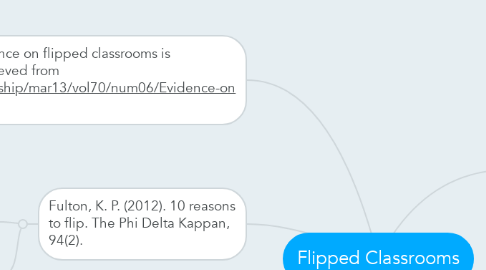Flipped Classrooms
por Kacie Gibbs


1. Horn, M. (2013). The transformational potential of flipped classrooms different strokes for different folks. Education Next.
1.1. makes class time more active, and lectures more independent
1.2. The classoom becomes an interactive environment that engages students more directly in their education
1.3. Students decide what to watch and when, which theoretically at least, gives them greater ownership over their learning” (Horn, 2013).
2. Milman, N. B. (2012). The flipped classroom strategy what is it and how can it best be used?. Ends and Means, 9(3).
2.1. frees up valuable class time for more engaging activites
2.2. This stragey has been attributed two Colorado high school teachers; Jonathan Bergman and Aaron Sams
2.3. Limitations
2.3.1. Quality of videos may be poor
2.3.2. may not be enough scaffolding for students
3. Goodwin, B., & Miller, K. (2013). Research says/ evidence on flipped classrooms is still coming in. Technology-Rich Learning, 70(6). Retrieved from http://www.ascd.org/publications/educational-leadership/mar13/vol70/num06/Evidence-on -Flipped-Classrooms-Is-Still-Coming-In.aspx
3.1. Hold lots of potential
3.1.1. Seems to only be used for math
3.1.2. Students can take in information at their own pace
3.1.2.1. putting lectures online enables students to pace their own learning according to their needs.
3.1.3. Positive teacher student relations: Research makes a strong case for the benefits of such interaction. Studies have shown that having teachers who recognize and respond to students' social and emotional needs is at least as important to academic development as specific instructional practices are, and this is especially true for at-risk students (Hamre & Pianta, 2005).
